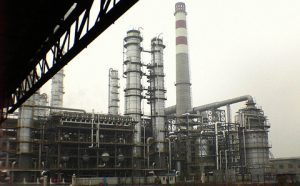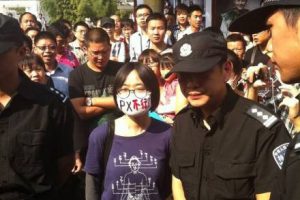China’s chemical industry has a major public relations problem. Since 2012, there have been numerous protests against plans for chemical plants near urban centres, such as in Dalian and Xiamen in 2012. Public concern has become focused on the production of paraxylene (PX), a carcinogenic chemical used in manufacturing fabrics and plastic bottles. In Kunming, capital of Yunnan province, fears about the construction of a PX plant caused almost 3,000 locals to take to the streets in May this year, prompting Mayor Li Wenrong to start up a microblog to communicate with the citizens.
Though there have been some attempts to reassure the public that PX is safe – a People’s Daily article trumpeted the fact that it was safer than caffeine – there are now indications of a more structured campaign to win back the Chinese public’s trust. Yunnan Satellite TV recently broadcast a four part series on oil refining and PX production in Japan, which showed how industry and the environment have co-existed for twenty years without any accidents, and transparency of information.
“There’s no doubt the station did this to reduce opposition to the petrochemical industry,” said Yi Peng, a researcher at the National Development and Reform Commission’s China Center for Urban Development. “The government trying to offer explanations in the face of opposition is a sign of progress.”
The PR campaign isn’t restricted to Yunnan. At Zhejiang’s annual National People’s Conference (NPC), many political figures called for PX to be “de-demonised.” At the NPC meeting in Beijing, Cao Xianghong, a member of the Chinese Academy of Engineering, submitted a proposal on “eliminating chemical industry-phobia,” suggesting that the state fund public education campaigns on the industry, including PX manufacturing.
There have also been other media campaigns. In May this year, Chinese state television broadcast a report on “the truth about PX”, which was followed up by a “removing the PX veil” item on a primetime news show. A month later, on June 24, the People’s Daily newspaper published a special investigation under the same title. Experts such as Jin Yong, a Tsinghua University professor and member of the Chinese Academy of Engineering, and Cao Xianghong have often been quoted in reports on PX.
“This was on an unprecedented scale,” said one former Sinopec executive. “And Cao and Jin are real heavyweight authorities in the industry, but they hardly ever speak to the media.”
These programs and reports reiterated that current evidence does not prove that PX is carcinogenic, and that overseas PX plants are placed less than one kilometre from residential areas.
Zhou Shengxian, minister for environmental protection, added his endorsement of PX, saying there was a need for more public education on PX. He said that PX production does involve some environmental risks, but with strict management the chances of an accident can be kept very low.
A successful example
Few people realise that during the peak of PX protests in Kunming and Chengdu, the Party Central General Office was writing to the Fujian city of Zhangzhou, asking for its experience and advice on telling locals about an incoming PX project. Zhangzhou is the site of the PX facility that was relocated from Xiamen after protests in 2008. Guo Chen, head of the petrochemical and chemical department at the China International Engineering Consulting Corporation (CIECC), explained that “the Tenglong plant was the only PX project approved during the 11th Five Year Plan.” A Zhangzhou public official who was unwilling to be named said that “mainly they wanted us to tell them how we’d persuaded the public.”
Many PX projects have been halted due to public opposition. The Zhangzhou project and the public relations behind it are seen as an alternative to the current approach of halting projects at the first sign of unrest.
Huang Jianhua, head of the Zhangzhou environmental protection bureau, said that in the latter half of 2012 the city started to receive government delegations from places such as Taizhou and Nantong – coming to see what the Party’s Publicity Department called a classic example of good publicity work.
The city’s response to the Party Central General Office described the Zhangzhou approach as involving: “wide public participation in the environmental impact assessment, reports from petrochemical experts, cadres visiting villages and households, overseas and domestic study trips to petrochemical facilities, positive publicity…”
It is unclear how that report was disseminated, but the Zhangzhou approach is now being replicated in Kunming and Chengdu. To calm opposition to the Pengzhou petrochemical and PX project, Chengdu is planning to send members of the public to visit similar plants in Singapore and South Korea in July and August.
Since February, more than 50 groups of representatives of various parts of Chengdu society have visited the Pengzhou site. Afterwards, positive feedback from the visitors is featured in local media.
Experts that were rarely-seen started to meet the public. Kunming invited five experts, including Cao Xianghong, to give a lecture, while Chengdu hosted Chen Wenlong of CIECC, who participated in petrochemical planning for the province. There were also a range of discussion meetings, news conferences and exhibitions.
Guo Weiqing, a professor at Sun Yat-Sen University’s School of Government, said that “by looking for multiple routes to resolving complaints, the government has softened its posture somewhat.”
“More publicity, but also more control”
But despite this barrage of PR, there are also indications that providing the public with ‘science’ alone will not remove their fears. As well as objecting to PX production, the protestors in Kunming and Chengdu have been opposed to entire refinery projects.
“The public misunderstandings are no longer confined to PX, they’ve spread to the entire petrochemical sector,” said Bai Xuesong, senior engineer at the China National Petroleum and Chemical Planning Institute.
Many petrochemical experts say that the intensive public relations efforts are a price being paid for earlier mistakes. “The fears are a result of environmental pollution caused by chemical industries and weak supervision,” said Cao Xianghong.
There have also been major miscalculations in how some of the campaigns to win public approval have been handled. In May the deputy chair of Yunnan’s development and reform commission told reporters that the environmental impact assessment report for the PX project could not be released. This caused both protest and suspicion, so much that even the release of the report a month later did not quell public concerns. An official involved with publicity for the Zhangzhou project said that damage to the government’s image had already been done.
Similar mistakes have been made in other cities. In Kunming there were experiments with openness – the mayor started a microblog, and discussion meetings were held. But on the other hand, residents were forced to show identification when buying facemasks (a rule now dropped). In Chengdu, fliers calling for calm were put through residents’ doors – but when a Sichuan University professor stepped outside wearing a facemask, the police ordered its removal.
“There’s more publicity, but also more control,” said Ai Nanshan, head of Sichuan University’s Institute of Environmental Science and Engineering.
According to Guo Weiqing, there is a logic to local government behaviour. “It’s linked to the fragmented and executive nature of the Chinese political system.” When protests look likely, even moderate policy-makers are likely to turn to traditional methods of maintaining stability. Solving this problem requires mechanisms for consultations between government and society – but those cannot be built overnight.
Why does PX matter?
Though PX has become synonymous with the entire Chinese chemical industry, there are other reasons for the Chinese government’s PR blitz. “The reason they’re making such a show about cleaning up PX’s name, is because it had got to the point where there was no other option,” said one anonymous former Sinopec executive. “PX production has been held back for too long.”
According to NDRC figures, by 2010 there were 13 applications for new or expanded PX facilities under consideration, with extra production to be over 8 million tonnes of the chemical. “Lots were planned, but progress was slow on some, and very few actually got into production,” said Guo Chen of CIECC.
Official figures put existing and under-construction PX production capacity at 12.3 million tonnes, 6 million tonnes less than demand. Last year alone almost 7 million tonnes were imported.
The former Sinopec executive said that although the price of PX has fluctuated, it has done so at a high level of around 10,000 yuan a tonne – making it one of the most profitable parts of the chemical industry.
This chronic undersupply makes it hard for chemical companies to resist expanding. The former Sinopec executive went on to say that his company alone had 10 subsidiaries intending to build or expand PX facilities in Maoming, Luoyang, Tianjin and elsewhere. The Southern Weekend learned that there are also once again plans to expand production at the Dalian Fujia-Dahua plant.
The publicity campaign for PX is clearly not just about yesterday’s mistakes, or ensuring stability today. Its true aim is to clear a path for further PX expansion.
This article was originally published in the Southern Weekend






